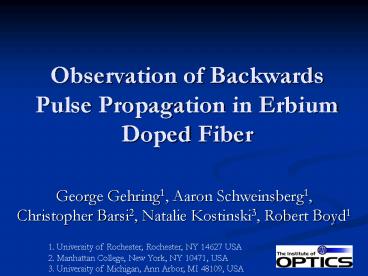Observation of Backwards Pulse Propagation in Erbium Doped Fiber - PowerPoint PPT Presentation
1 / 19
Title:
Observation of Backwards Pulse Propagation in Erbium Doped Fiber
Description:
Observation of Backwards Pulse Propagation in Erbium Doped Fiber ... Christopher Barsi2, Natalie Kostinski3, Robert Boyd1 ... In dispersive media, pulses ... – PowerPoint PPT presentation
Number of Views:78
Avg rating:3.0/5.0
Title: Observation of Backwards Pulse Propagation in Erbium Doped Fiber
1
Observation of Backwards Pulse Propagation in
Erbium Doped Fiber
- George Gehring1, Aaron Schweinsberg1,
Christopher Barsi2, Natalie Kostinski3, Robert
Boyd1
1. University of Rochester, Rochester, NY 14627
USA2. Manhattan College, New York, NY 10471,
USA3. University of Michigan, Ann Arbor, MI
48109, USA
2
Slow and Fast Light
- In dispersive media, pulses propagate at the
group velocity - Dispersion and gain/absorption linked through the
Kramers-Kronig relations - Coherent Population Oscillations (CPO) utilized
to create narrow spectral hole in an absorption
or gain feature
3
Coherent Population Oscillations
- The excited state population oscillates at the
beat frequency between pump and probe fields - Resultant spectral hole can be very narrow,
creating a rapid change in the refractive index
Hillman, Boyd, Krasinski and Stroud, Jr.,Optics
Communications 45, No. 6, 416-419 (1983).
Coherent Population Oscillation effect in a ruby
crystal.
4
Why EDOF?
- Erbium doped optical fiber exhibits gain or loss
depending on optical pumping power at 980 nm - Fiber geometry is favorable
- Tight confinement
- Large interaction lengths
5
CPO Bandwidth
- Useful spectral region limited by the width of
the spectral hole - This width is inversely proportional to the
excited state lifetime, and can be power
broadened by the pump and signal fields
A. Schweinsberg, N. M. Lepeshkin, M. S. Bigelow,
R. W. Boyd, S. Jarabo, Europhysics Letters 73,
Issue 2, p218 (2006).
6
Broad Spectral Components
- If the pulse contains spectral content that lies
outside of this region, we expect the group
velocity prediction to break down. - If only a small part of the pulse power lies
- outside the window, the bulk of the pulse will
still propagate at the expected group velocity.
7
Broad Spectral Components
- Discontinuity propagates at phase velocity, while
bulk of pulse experiences delay
8
BSC3
9
Negative Group Velocity
- When erbium fiber is pumped with 980nm light, it
becomes an amplifier - CPO will then create a spectral hole in the gain
profile, making dn/d? sufficiently negative - The group velocity becomes negative
- Pulse is advanced in time, with the peak of the
output pulse exiting the material before the peak
of the input pulse enters
10
Negative Group Velocity
- Inside the material, the peak is expected to
travel backwards, linking output and input - This inspires some important questions
- Does this violate causality?
- Is energy conserved, and if so, in what direction
is energy flowing?
11
Instructional Video
M. Ware, S. Glasgow, and J. Peatross, Optics
Express 9, 519-532 (2001)
12
Experimental Setup
- Setup (a) is used to temporally resolve the
propagation within the fiber. - Setup (b) tests the direction of energy flow.
13
Example Data Trace
- Traces taken for lengths of fiber between 0 and
10 meters, in 25 cm intervals - These traces are then arranged spatially and
played back simultaneously
G. M. Gehring, A. Schweinsberg, R. W. Boyd, et
al. Science 312, 895 (2006).
14
Video Frames
- Effects of gain removed to improve clarity
- Arrows emphasize peak positions inside and
outside the material - Peak position is clearly seen to travel from
right to left inside the material - ng -4000
15
Video Gain Removed
16
Video Frames
- Signal gain included
- Peak inside the material travels backward, but
not with the predicted group velocity - This is due to the exponential background
created by the signal gain.
17
Video Gain Included
18
Energy Transport Direction
- When bi-directional couplers were added between
segments of EDOF, the output on ports B and D
agreed with previous results. - Output on ports A and C were barely above noise
threshold, and consistent with expected back
reflections.
19
Summary
- Erbium doped fiber allows the study of exotic
pulse propagation effects based on CPO - Propagation of discontinuities
- Negative group velocities (backward propagation)
- For a pulse propagating through a medium with a
negative group velocity - Pulse peak within the material moves backwards
- Energy transport is always in the forward
direction
20
Acknowledgements
- Nonlinear Optics Group
- http//www.optics.rochester.edu/boyd/
- Financial support from
- DARPA/DSO Slow Light program
- NSF































